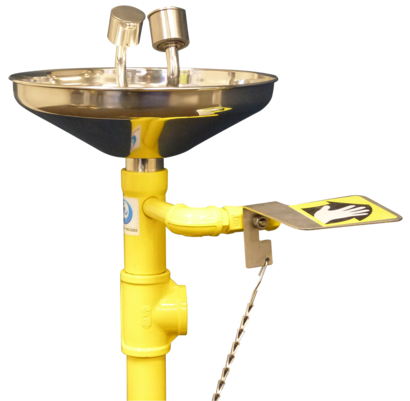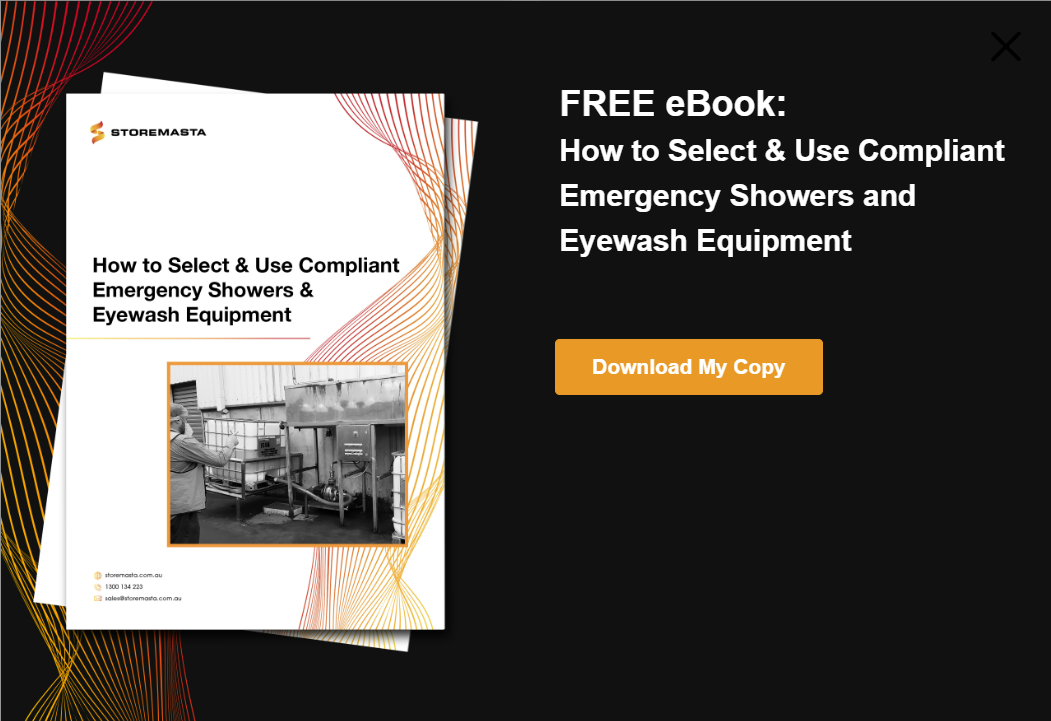In the event of a chemical exposure burn, it’s crucial that the eyes are irrigated as quickly as possible to minimise tissue damage. Staff who can flush their eyes with water within 10 minutes of the injury occurring will suffer less severe injuries with shorter periods of hospitalisation required. In this post, we explain how to use an eyewash station to treat chemical burns in the workplace.
Chemical Burns To The Eyes
Chemical burns can occur in a multitude of work settings including laboratories, decanting areas, construction sites, commercial vessels, oil and gas refineries and food manufacturing plants. While hazardous liquids splashing over the face are the most common type of injury, chemical burns also happen when toxic and corrosives dusts/powders are blown into the eyes.
Examples of chemical burns may include:
- Flammable liquids splashing onto the face when refuelling a vehicle
- Acid spraying onto the face after a connector hose slips from a fitting
- Cement powder blowing into the eyes while mixing
- Rubbing or scratching the eyes after handling corrosive chemicals
- Pesticides leaking from a sprayer and soaking into headwear
- Liquid chemicals penetrating ill-fitting goggles and facial PPE
To protect your team from the eye damage from chemical exposure, we recommend always carrying out a risk assessment at your site. This risk assessment will help you determine the ways in which workers could suffer eyes injuries — and the likelihood of it happening. A risk assessment will also guide you as to whether your workplace actually requires an eyewash station.
Once your risk assessment is complete, you can then make sure your eye wash stations are installed key locations that could best serve injured workers. Refer to the eyewash station requirements under WHS laws and the Australian Standards to assist with your installation of the emergency decontamination equipment.
IMPORTANT: The eyes are soft tissue organs and very vulnerable to trauma, so never use emergency showers and drench hoses to flush the eyes. Dedicated eyewash units, that are manufactured to Australian Standards, regulate water pressure, so the decontamination process is safe for the eyes.
Using The Eyewash Equipment After Chemical Exposure
The chemical emergency eyewash procedure involves the prompt irrigation of the eyes after chemical exposure. Activate the eyewash station and hold the eyelids open while the water washes the eyeballs. To ensure that all chemicals are removed from the eye, gently roll your eyeballs in all directions and allow the water to irrigate beneath the eyelids. Emergency eyewash stations provide a steady stream of water for both eyes, so make sure that both eyes are decontaminated, regardless of whether you believe it’s one or two eyes that have been affected. If you wear contact lenses, don’t try to remove them prior to flushing. Activate the eye wash station as soon as possible then remove contact lenses as you continue to irrigate the eyes.
How Long to Flush Eyes After Chemical Exposure?
To reduce the risk of permanent eye injuries, make sure that you rinse the eyes for at least 15 minutes before seeking emergency medical attention.
Sufficient irrigation of the eye through the use of an eye wash station is required to reduce the risk of permanent eye damage.
IMPORTANT: When there’s chemical exposure in the workplace, other hazards can also be present. When making your way to the emergency eyewash facility, beware of peripheral hazards like slippery floors, dropped PPE, or chemical residues that might contact other body parts (or first aiders).
Eye Wash Instructions
Training and emergency drills are essential in helping staff understand how to effectively use eyewash equipment. Create standard operating procedures for the emergency eyewash station and drill staff on the procedure for tending to a chemical burn.
The following are some basic steps that may be required for emergency decontamination of the eyes:
- Get the injured worker to the eyewash station as quickly as possible, even a few extra seconds could mean permanently blindness or death.
- Activate the eyewash unit using the single hand/foot action. The dust covers will open automatically with the water flowing continuously until it’s manually switched off.
- With the eyes open (use fingers to hold the eyelids) lower eyes into the water stream.
- If only one eye has been contaminated, try to keep the uninjured eye higher (to avoid cross contamination.)
- Gently roll the eyeballs (up and down, side to side) aiming to get as much water as possible into the eye area.
- Contact lenses should be removed as soon as you can, but never stop flushing.
- Continue flushing for 15-60 minutes based on the recommendations of the Safety Data Sheet (SDS) or a medical practitioner.
The usage instructions above are generic, so only use them as the basis for your own work procedures. Emergency eyewash procedures should always be developed to meet the specific chemical hazards located at your own job site.
Keeping Your Eyewash Equipment Operational
Imagine installing an eyewash facility, only to have the equipment not working correctly (or being complexly inoperatable) when you’re faced with a chemical emergency.
Here’s our 3 workplace essentials for making sure that never happens:
1. Carry Out Eyewash Station Maintenance and Testing
It’s an essential requirement under AS 4775-2007 - Emergency eyewash and shower equipment to ensure your eyewash station is properly maintained.
Plumbed eyewash stations must be activated at least once a week to verify they are operational, plus clear the water supply line of any buildup of sediment. This also minimises the likelihood of stagnant water and an accumulation of microbial contaminants.
Both plumbed and self-contained eyewash stations must be inspected and tested each year by a technician who is qualified to certify and tag the units.
Self-contained eyewash equipment (which have their own limited supply of flushing fluid) require regular monitoring to ensure the flushing fluid remains intact.
Need to update your eyewash equipment?
Schedule an appointment with our DG Specialists
2. Clean Up After Using the Decontamination Unit
If you’ve had a chemical emergency and had to use your eyewash equipment, it’s essential that the unit is cleaned as soon as possible. Make sure that all chemical residues are removed, this includes the paddle levers, both water nozzles, and covers.
At the same time, activate the unit to make sure that it’s still fully operational.
For self-contained emergency eyewash units, you’ll need to determine their suitability for reuse and then refill the tank.
3. Don’t Allow Workers To Misuse Safety Equipment
Eyewash stations are exclusively for use during an emergency — they must never be used for another purpose. Using the facility as a common hand-wash area (or for other non-emergency tasks) could expose the unit to unnecessary wear or cause damage/contamination to the unit.
Create standard operating procedures so that you can train staff and contractors to use the equipment correctly. Make sure supervisors or team leaders are enforcing this requirement.
Training and induction programs should have specific content stipulating that eyewash stations are NOT:
- Common hand and face washing facilities
- Laundry stations for washing stains from clothing
- Cleaning sinks for PPE or safety equipment
- Clothes lines or sites for hanging stuff
- The place to wash fruit, smoko containers, or eating utensils
Remind your staff that chemical emergencies can happen on any shift at any time. No one wants to be responsible for a staff member suffering a permanent injury simply because the emergency eyewash unit wasn’t maintained and used as it should be.
How to Use an Eyewash to Reduce Risk of Human Harm
If you’re considering installing, upgrading or expanding the emergency eyewash facilities at your workplace, we recommend downloading our free eBook. How to select and use compliant emergency showers and eyewash equipment is an excellent resource that will help you determine the eyewash unit that will best suit your safety and compliance requirements. For any other enquiries regarding an eyewash station, or outdoor emergency showers or other equipment, reach out to our DG Storage Specialists who can tailor a solution for your workplace.
Joining the team as a Dangerous Goods Storage Consultant, Melissa Hampton became Storemasta's Marketing Manager in late 2021. With extensive knowledge and experience in chemical compliance, Melissa is responsible for leading the Marketing team and helping shape their marketing strategy. In her spare time, you can find Melissa hiking, swimming and enjoying the great outdoors in beautiful north-west Tasmania.

